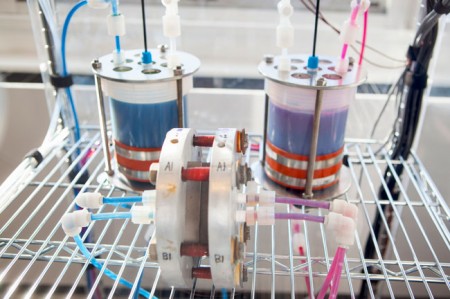Chemists have developed a major improvement to capture and retain energy from sunlight, where the stored energy can last dramatically longer than current solar technology allows — up to several weeks, instead of the microseconds found in today’s rooftop solar panels.
The new design is inspired by the way that plants generate energy through photosynthesis. It is capable of storing solar energy for up to several weeks – an advancement for designers that could change phase of our present solar cells.
Biology does a very good job of creating energy from sunlight in plants. Plants do this through photosynthesis with extremely high efficiency. In photosynthesis, plants that are exposed to sunlight use carefully organized nanoscale structures within their cells to rapidly separate charges — pulling electrons away from the positively charged molecule that is left behind, and keeping positive and negative charges separated. That separation is the key to making the process so efficient.
To capture energy from sunlight, conventional rooftop solar cells use silicon, a fairly expensive material. There is currently a big push to make lower-cost solar cells using plastics, rather than silicon, but today’s plastic solar cells are relatively inefficient, in large part because the separated positive and negative electric charges often recombine before they can become electrical energy.
Modern plastic solar cells don’t have well-defined structures like plants do because we never knew how to make them before. But this new system pulls charges apart and keeps them separated for days, or even weeks. Once designer make the right structure, scientist can vastly improve the retention of energy.
The two components on which developed system work are a polymer donor and a nano-scale fullerene acceptor. The polymer donor absorbs sunlight and passes electrons to the fullerene acceptor; the process generates electrical energy.
The plastic materials, called organic photovoltaics, are typically organized like a plate of cooked pasta — a disorganized mass of long, skinny polymer ‘spaghetti’ with random fullerene ‘meatballs.’ But this arrangement makes it difficult to get current out of the cell because the electrons sometimes hop back to the polymer spaghetti and are lost.
The researchers arranges the elements more neatly — like small bundles of uncooked spaghetti with precisely placed meatballs. Some fullerene meatballs are designed to sit inside the spaghetti bundles, but others are forced to stay on the outside. The fullerenes inside the structure take electrons from the polymers and toss them to the outside fullerene, which can effectively keep the electrons away from the polymer for weeks.
When the charges never come back together, the system works far better. Researchers have really worked hard in designing using modern synthetic organic photovoltaic materials. In the new system, the materials self-assemble just by being placed in close proximity.
The new design is also more environmentally friendly than current technology, because the materials can assemble in water instead of more toxic organic solutions that are widely used today.
Once the materials is made, it can be dumped into water and it assemble into the appropriate structure because of the way the materials are designed. So there’s no additional work.
The researchers are already working on how to incorporate the technology into actual solar cells. These materials are waiting to be fit in a real device yet. For now, though, the research has proven that inexpensive photovoltaic materials can be organized in a way that greatly improves their ability to retain energy from sunlight.

